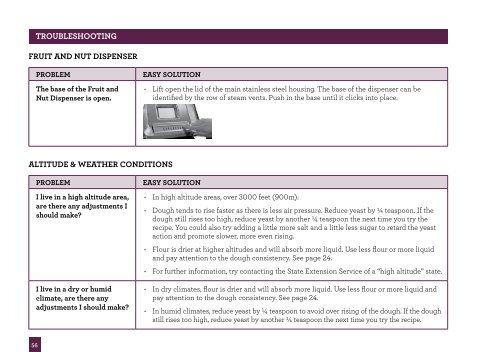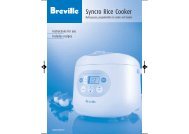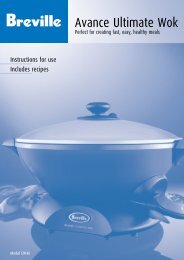the Custom Loaf - Breville
the Custom Loaf - Breville
the Custom Loaf - Breville
Create successful ePaper yourself
Turn your PDF publications into a flip-book with our unique Google optimized e-Paper software.
56<br />
TROUBLESHOOTING<br />
FRUIT ANd NUT dISPENSER<br />
PROBLEM EASy SOLUTION<br />
The base of <strong>the</strong> Fruit and<br />
Nut dispenser is open.<br />
ALTITUdE & WEATHER CONdITIONS<br />
PROBLEM EASy SOLUTION<br />
I live in a high altitude area,<br />
are <strong>the</strong>re any adjustments I<br />
should make?<br />
I live in a dry or humid<br />
climate, are <strong>the</strong>re any<br />
adjustments I should make?<br />
• Lift open <strong>the</strong> lid of <strong>the</strong> main stainless steel housing. The base of <strong>the</strong> dispenser can be<br />
identified by <strong>the</strong> row of steam vents. Push in <strong>the</strong> base until it clicks into place.<br />
• In high altitude areas, over 3000 feet (900m):<br />
• Dough tends to rise faster as <strong>the</strong>re is less air pressure. Reduce yeast by ¼ teaspoon. If <strong>the</strong><br />
dough still rises too high, reduce yeast by ano<strong>the</strong>r ¼ teaspoon <strong>the</strong> next time you try <strong>the</strong><br />
recipe. You could also try adding a little more salt and a little less sugar to retard <strong>the</strong> yeast<br />
action and promote slower, more even rising.<br />
• Flour is drier at higher altitudes and will absorb more liquid. Use less flour or more liquid<br />
and pay attention to <strong>the</strong> dough consistency. See page 24.<br />
• For fur<strong>the</strong>r information, try contacting <strong>the</strong> State Extension Service of a “high altitude” state.<br />
• In dry climates, flour is drier and will absorb more liquid. Use less flour or more liquid and<br />
pay attention to <strong>the</strong> dough consistency. See page 24.<br />
• In humid climates, reduce yeast by ¼ teaspoon to avoid over rising of <strong>the</strong> dough. If <strong>the</strong> dough<br />
still rises too high, reduce yeast by ano<strong>the</strong>r ¼ teaspoon <strong>the</strong> next time you try <strong>the</strong> recipe.

















